Archive for December, 2019
-
MALTA’S PREHISTORIC TREASURES
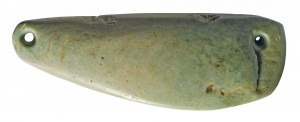 Who knows whose neck the exotic jadeite amulet adorned? To reach the Maltese shores, this item travelled a very long distance in prehistoric times. Therefore, it must have been really treasured, raising the status of its owner. It is difficult to see a symbolic meaning in such an amulet, however, it was chosen to accompany an individual who was laid to rest at the Xagħra Circle in Gozo.
Who knows whose neck the exotic jadeite amulet adorned? To reach the Maltese shores, this item travelled a very long distance in prehistoric times. Therefore, it must have been really treasured, raising the status of its owner. It is difficult to see a symbolic meaning in such an amulet, however, it was chosen to accompany an individual who was laid to rest at the Xagħra Circle in Gozo.We all know that person who would throw nothing away, and keeps mending an object till the very last. Well, it seems that such persons have existed since prehistoric times. A jar which was unearthed at Skorba Temples was drilled with pairs of holes above and below the crack to tie the two parts together with a long string. Who could tell whether these interventions served their purpose?
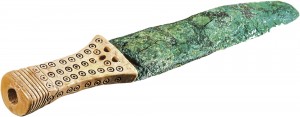 To whom did the elegant bone and copper dagger, that was discovered at Għar Mirdum in Dingli Cliffs, belong? Clearly designed for prestige rather than for defence, such a lovely object is unlikely to have been casually lost. So why was it left in this buried cave?
To whom did the elegant bone and copper dagger, that was discovered at Għar Mirdum in Dingli Cliffs, belong? Clearly designed for prestige rather than for defence, such a lovely object is unlikely to have been casually lost. So why was it left in this buried cave?Was the heavily pregnant female clay figure which was found at the Tarxien Temples, pierced in sixteen places with sharp fragments of shell, really intended to curse an opponent by magical means? And did the magic spell work?
While the first clay figure of the Sleeping Lady that was found in the Hypogeum of Ħal Saflieni rested on its side, another one discovered at the same site, lies face down with her breasts hidden beneath her. If either or both these figures could come to life, they would tell us a great deal about what we should dearly like to know about themselves and their times, though we might have great difficulty in understanding what they had to say. What would it take to wake them up?
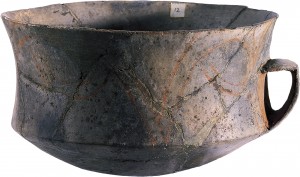 Archaeological discoveries are not only made in main sites. Nearby locations could be as significant for further revelations. The remains of a carinated clay offering bowl was recovered during investigations in the North Cave at the megalithic site of Ġgantija. Decorated with coloured scratched volutes, this bowl must have been considered sacred enough so as not to be casually scattered. It would be so intriguing to know in which rituals it was used.
Archaeological discoveries are not only made in main sites. Nearby locations could be as significant for further revelations. The remains of a carinated clay offering bowl was recovered during investigations in the North Cave at the megalithic site of Ġgantija. Decorated with coloured scratched volutes, this bowl must have been considered sacred enough so as not to be casually scattered. It would be so intriguing to know in which rituals it was used.These are only a few of the engaging narratives which form part of the collection of fifty artefacts in Heritage Malta’s latest publication “Malta’s Prehistoric Treasures”.
Skillfully chosen from the National Collection by the renowned late archaeologist Dr. David Trump, the artefacts are intended to accompany the readers along a personal journey in Maltese prehistory which fascinated him so much.
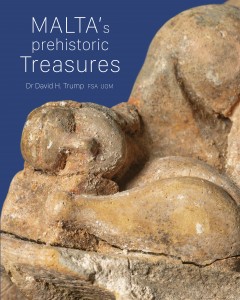 This makes the book even more significant since the selected artefacts are not only allowing the readers to learn about the local prehistoric people but also to see through the eyes of a very inspirational archaeologist.
This makes the book even more significant since the selected artefacts are not only allowing the readers to learn about the local prehistoric people but also to see through the eyes of a very inspirational archaeologist.The book has an additional narrative by Heritage Malta Senior Curator, Sharon Sultana.
Photography and design by Daniel Cilia.
Malta’s Prehistoric Treasures is available from Heritage Malta sites and museums.
For more information, visit www.heritagemalta.org
(This feature was published in The Times of Malta issued on 30th December 2019)
-
THE MAGIC IS IN THE DETAIL
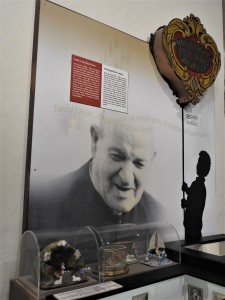 Although the main characters of the nativity scene are Joseph, Mary and baby Jesus, different cultures have added and altered the original representation in order to include their own characteristics. Some of these varying interpretations can be viewed in a permanent exhibition at the Inquisitor’s Palace in Birgu, which also houses the National Museum of Ethnography.
Although the main characters of the nativity scene are Joseph, Mary and baby Jesus, different cultures have added and altered the original representation in order to include their own characteristics. Some of these varying interpretations can be viewed in a permanent exhibition at the Inquisitor’s Palace in Birgu, which also houses the National Museum of Ethnography.In Malta, it was St George Preca (1880 – 1962) who fostered a lasting Christmas cult through his Society of Christian Doctrine. On Christmas Eve of 1921, he organized the first procession with a statue of baby Jesus. He also started the tradition of giving a crib and a statue of baby Jesus to every child who attended the MUSEUM centres.
In the exhibition, an image of Preca looks over at a rudimentary crib which has initiated a tradition that is still celebrated nowadays. A detailed diorama portrays further this tradition, showing a MUSEUM Superior handing out a crib to a boy, while a number of other children are already joyfully holding their cribs. An altar which is included in the diorama is decorated with flowing white vetch.
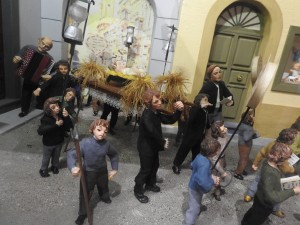 Another diorama looks like a time capsule showing the traditional procession of baby Jesus together with other local customs. Not only can one observe the MUSEUM members carrying the statue of baby Jesus, but one can also delight at the children carrying lights and Christmas messages while singing Christmas carols. The context is further enriched by the presence of traditional Maltese town houses, with their colourful wooden doors and with their wide open windows decorated with a small statue of baby Jesus.
Another diorama looks like a time capsule showing the traditional procession of baby Jesus together with other local customs. Not only can one observe the MUSEUM members carrying the statue of baby Jesus, but one can also delight at the children carrying lights and Christmas messages while singing Christmas carols. The context is further enriched by the presence of traditional Maltese town houses, with their colourful wooden doors and with their wide open windows decorated with a small statue of baby Jesus.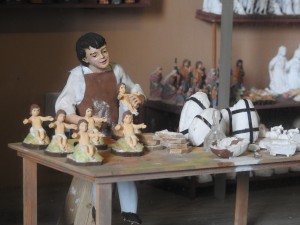 These two dioramas form part of a set that was donated to Heritage Malta by Austin Galea; a well-established artisan and personality among local crib enthusiasts, and a founding member of the Għaqda Ħbieb tal-Presepju (Malta). The set of dioramas give life to further Christmas traditions, such as the sermon of the altar boy during Christmas’ eve mass, a large crib displayed for public viewing, a group of craftsmen in a workshop manufacturing statues and cribs, and a Christmas lunch being enjoyed by a family.
These two dioramas form part of a set that was donated to Heritage Malta by Austin Galea; a well-established artisan and personality among local crib enthusiasts, and a founding member of the Għaqda Ħbieb tal-Presepju (Malta). The set of dioramas give life to further Christmas traditions, such as the sermon of the altar boy during Christmas’ eve mass, a large crib displayed for public viewing, a group of craftsmen in a workshop manufacturing statues and cribs, and a Christmas lunch being enjoyed by a family.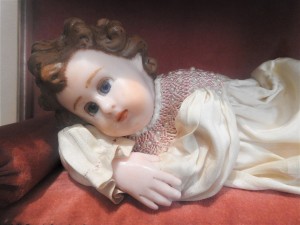 Galea has also donated two large nativity scenes which are typically exhibited in windows of private houses during the Christmas season in Malta. Other donations by him include different traditional statues of baby Jesus. Traditionally, the baby Jesus statues were made of wax to obtain a soft and translucent finish. The statues were eventually dressed up in an embroidered tunic, while many borrowed real hair from a toddler’s crowning curls.
Galea has also donated two large nativity scenes which are typically exhibited in windows of private houses during the Christmas season in Malta. Other donations by him include different traditional statues of baby Jesus. Traditionally, the baby Jesus statues were made of wax to obtain a soft and translucent finish. The statues were eventually dressed up in an embroidered tunic, while many borrowed real hair from a toddler’s crowning curls.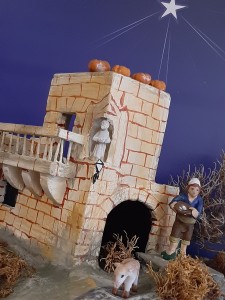 A large Maltese crib is also part of Galea’s generous donation. The crib is a comprehensive study of Maltese traditions in itself. Typical Maltese figurines are dressed in traditional local costumes, and among them, one also finds the unique Maltese symbolic characters. The Stupefied figurine represents those who are impressed by the profound meaning of the unique happening. The Beggar represents the poor who find consolation in Christ. The Climber represents those who find it difficult to understand the significance of Christ’s incarnation but strive to discover out. The Folk Singers represent communal association in praising the Lord, while the Sleeper represents those who ignore the immeasurable benevolence of Christ. The rugged landscape with its terraced fields, sparse vegetation, low-profile unpretentious farmhouses and a windmill are reminiscent of the rural ambience of the old times.
A large Maltese crib is also part of Galea’s generous donation. The crib is a comprehensive study of Maltese traditions in itself. Typical Maltese figurines are dressed in traditional local costumes, and among them, one also finds the unique Maltese symbolic characters. The Stupefied figurine represents those who are impressed by the profound meaning of the unique happening. The Beggar represents the poor who find consolation in Christ. The Climber represents those who find it difficult to understand the significance of Christ’s incarnation but strive to discover out. The Folk Singers represent communal association in praising the Lord, while the Sleeper represents those who ignore the immeasurable benevolence of Christ. The rugged landscape with its terraced fields, sparse vegetation, low-profile unpretentious farmhouses and a windmill are reminiscent of the rural ambience of the old times.Besides donating his first clay crib figurines which were given to him by his aunties and an unusual crib made of sacks that was constructed by him, Galea shares also his knowledge relating to Christmas crib construction in a short video which forms part of this exhibition.
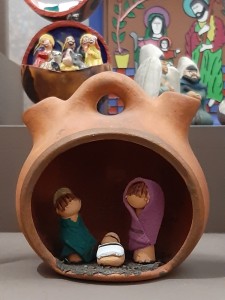 Another intriguing element in this exhibition is the donation of numerous miniature cribs which were brought by Albert and Lina McCarthy from all over the world. The professional tour managers have been gathering this impressive collection since the early 90s. Their collection amounts to more than 500 miniature works of art, a representative selection of which is on display at the Inquisitor’s Palace.
Another intriguing element in this exhibition is the donation of numerous miniature cribs which were brought by Albert and Lina McCarthy from all over the world. The professional tour managers have been gathering this impressive collection since the early 90s. Their collection amounts to more than 500 miniature works of art, a representative selection of which is on display at the Inquisitor’s Palace.Exhibited in four different sections, the varying nativity scenes representing North and East Europe, Southern Europe and the Near East, North and South America, and Africa, Asia, the Far East and Australia are simply enchanting. The magic is in the detail of each crib which presents the nativity scene in various contexts, with distinct characters and in diverse materials.
 Some of the most notable are the terracotta nativity sets from Hungary and Peru, the ceramic sets from Denmark and the Philippines, the engraved wooden shoe from Amsterdam, the wooden sets of Germany, Austria, Japan and Iran, the metallic artwork from Bali, the sack nativity set from Sri Lanka and the clay figurines of North Africa set in a bedouin tent, dressed in traditional costumes and accompanied by a camel instead of farm animals.
Some of the most notable are the terracotta nativity sets from Hungary and Peru, the ceramic sets from Denmark and the Philippines, the engraved wooden shoe from Amsterdam, the wooden sets of Germany, Austria, Japan and Iran, the metallic artwork from Bali, the sack nativity set from Sri Lanka and the clay figurines of North Africa set in a bedouin tent, dressed in traditional costumes and accompanied by a camel instead of farm animals.A visit to this permanent exhibition held at the Inquisitor’s Palace is most educational and entertaining for children, and also curious and insightful for adults. The exhibits are a tribute to local and foreign artisans who have used their creativity to reproduce the significant nativity scenes in various intriguing representations.
(Published in Christmas Times magazine issue with The Times of Malta dated 7th December 2019)
-
THE SELLING GAME
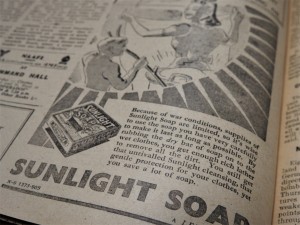 Advertising is said to reflect the societal tastes, beliefs and norms. By looking back at the adverts that were published in the Times of Malta at the end of the years 1939 to 1944, this becomes very clear. Yet even their absence during the days of war have much to say.
Advertising is said to reflect the societal tastes, beliefs and norms. By looking back at the adverts that were published in the Times of Malta at the end of the years 1939 to 1944, this becomes very clear. Yet even their absence during the days of war have much to say.There are whole studies and much research behind advertising. Adverts are used as a form of communication intended to convince an audience to purchase or take some action upon products, ideals or services. Their regularity aim to impact on memory to create a sense of familiarity and trust to buy those products.
Indeed, while turning the pages of November – December 1939 and 1940 of the Times of Malta, it is evident that a group of particular brands are always featuring. Most relate to health, beauty, alcohol, insurance, entertainment (mainly cinema), fashion and gifts.
Health adverts at the time generally focus on irritability of the stomach, laxatives, cold and fever, rheumatism, eczema, fatigue and sleeplessness. The message on the adverts is mainly delivered through drawings and long descriptions about the benefits of using the products.
 The text is generally presented in the form of a conversation – “Why continue to be agonised by Terrible Headaches, Niggling Nerve Pains, Black Depression, and Heavy-Limbed Lassitude?” – reads the introduction of an advert for tonic tablets.
The text is generally presented in the form of a conversation – “Why continue to be agonised by Terrible Headaches, Niggling Nerve Pains, Black Depression, and Heavy-Limbed Lassitude?” – reads the introduction of an advert for tonic tablets.“Do you realise the danger? Impure blood causes disease.” – says another advert selling a ‘blood mixture’ as ailment against rheumatism, lumbago, eczema, boils and pimples.
Communication with the readers is stark and direct – The word “Poisoned!” in capital black letters runs over the mouth of a man in the advert of a toothpaste. “Pyorrhoea has robbed him of his teeth, poisoned his whole system. Don’t let this happen to you.”
“Is running a house too much for you?” reads the title of an energy drink. “Do you feel that the cares of the household get you down and managing your servants is a strain?”
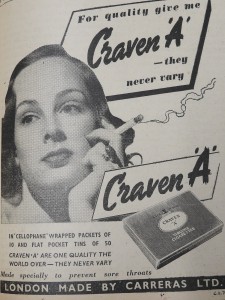 The quantity of adverts focusing on health issues form quite a big chunk of the advertising at the time. However, ironically, these are accompanied by cigarette adverts, one of which shows a beautiful young woman with a cigarette in her hand. A section of the advert text reads – “Made specially to prevent sore throats.”
The quantity of adverts focusing on health issues form quite a big chunk of the advertising at the time. However, ironically, these are accompanied by cigarette adverts, one of which shows a beautiful young woman with a cigarette in her hand. A section of the advert text reads – “Made specially to prevent sore throats.”Some of the adverts published at the time will certainly be unacceptable nowadays. Social class differences, sexism and offensive messages are quite typical.
“Women who belong to the 1st sleep group never grow old before their time. There are 3 groups. Which do you belong to?” – asks an advert selling Horlicks. “Most attractive women belong to the 1st sleep group.” – states another one. “Men who are sure of themselves belong to the 1st sleep group.” – and – “Men who get on in life nearly all belong to the 1st sleep group”.
 “Don’t look old! Tint those grey hairs with Shadeine.” – jumps at you an advert selling hair colour.
“Don’t look old! Tint those grey hairs with Shadeine.” – jumps at you an advert selling hair colour.Advertisements can influence strongly how we perceive things around us. By showing a high social class user of a product, the advert creates a longing or a pressure to purchase that item in order to belong to that level of society.
A skin-vitamin cream portrays the drawing of a beautiful lady, all dressed up in perfect make-up, set-up hair, a pair of lovely earrings and a crown. – “Lady Grenfell is one of the most beautiful among the young marrieds in Society…. She tells us, ‘I’m using Pond’s Creams containing the ‘skin-vitamin’, and they’re really amazing.”
“Many army and royal navy officers enjoy the comfort of our hand-made footwear. Why Not you? Sir.” – entices an advert showing the drawing of a highly elegant man sitting in a luxurious armchair while a shoe-maker sits on a stool to help him try on a new pair of shiny “Best English leather”.
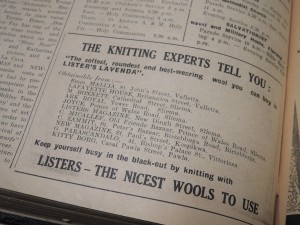 A shade of the effects of the Second World War, even though not yet happening in Malta is already present in adverts of 1939.
A shade of the effects of the Second World War, even though not yet happening in Malta is already present in adverts of 1939.“Keep yourself busy in the black-out by knitting with Listers – the nicest wool to use.” – advices an advert. “Bernards suggest that you give sensible gifts this Christmas. Such gifts as shirts, pyjamas, handkerchiefs, ties, socks, gloves and wool-slipovers all make very acceptable presents.” – recommends another one.
Not only adverts diminish in 1941 during the war days in Malta. Even the newspaper itself shrivels to a few pages although being published daily.
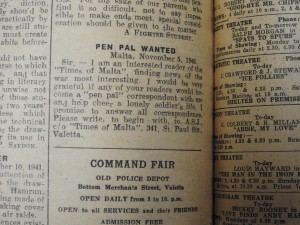 “Test your gas mask. Gas Chamber at Castile Place today.” – reads a warning advert on the front page of the Times of Malta on Tuesday, November 4, 1941. “There is no better way of ensuring that the respirator is still properly functioning than by putting it on and entering the gas chamber.”
“Test your gas mask. Gas Chamber at Castile Place today.” – reads a warning advert on the front page of the Times of Malta on Tuesday, November 4, 1941. “There is no better way of ensuring that the respirator is still properly functioning than by putting it on and entering the gas chamber.”Amid the difficulties of war, an advert speaks out the request for a pen pal – “I am an interested reader of the “Times of Malta”, finding news of the war most interesting. I would be very grateful if any of your readers would become a “pen pal” correspondent with me and help cheer a lonely soldier’s life.”
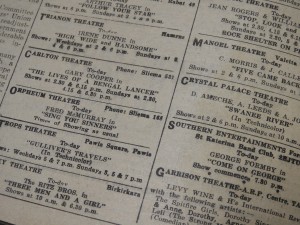 A considerable decrease of adverts continues in 1942. Alcohol adverts drop out completely. Cinema continues regularly in the following theatres – Manoel and Coliseum in Valletta, Gaiety, Majestic, Carlton and Orpheum in Sliema, Odeon, Thrianon and Rex in Ħamrun, Prince in Birkirkara, Buckingham and Royal in Żabbar, and Empire in Paola.
A considerable decrease of adverts continues in 1942. Alcohol adverts drop out completely. Cinema continues regularly in the following theatres – Manoel and Coliseum in Valletta, Gaiety, Majestic, Carlton and Orpheum in Sliema, Odeon, Thrianon and Rex in Ħamrun, Prince in Birkirkara, Buckingham and Royal in Żabbar, and Empire in Paola.“What do I do…. about the black market?” runs an advert issued by the Information Office. A Wartime Reminder advert issued by the same Office reminds people that “Imported Fuel is used for pumping Water. Reduced consumption of water saves Fuel. A saving in Fuel saves Freight, (and) Saving in freight helps to win the War.”
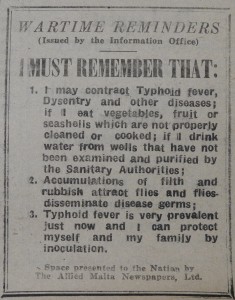 Another Wartime Reminder recommends the adequate washing of vegetables, fruit and seashells, and their proper cooking while warning against the accumulation of filth, since these may lead to Typhoid fever and Dysentry. Inoculation against the Typhoid fever is also advocated.
Another Wartime Reminder recommends the adequate washing of vegetables, fruit and seashells, and their proper cooking while warning against the accumulation of filth, since these may lead to Typhoid fever and Dysentry. Inoculation against the Typhoid fever is also advocated.The siege on the Maltese Islands effectively ended in November 1942. Yet adverts show that life took time to return to normal especially since the Second World War had not yet ended in other countries.
An advert issued by the N.F.U advices to eat cabbage and cauliflower to keep fit. Another advert informs its clientele that “Because of war conditions, supplies of Sunlight Soap are limited, so it’s wise to use the soap you have very carefully to make it last as long as possible.”
Even tennis balls were restored instead of purchasing new ones – “Hand in your old Tennis Balls to any of the Sports Dealers named below, who will forward them to Slazengers for renovation by a special process which includes reinflation and provision of a new outside cover.”
During the days of war, a few selected companies such as Bovril, managed to stay in the public eye through advertisements. “Makes all the difference between bread and butter.” The Bovril advert states. “A 4-oz. Bottle of Bovril makes over 100 delicious sandwiches.”
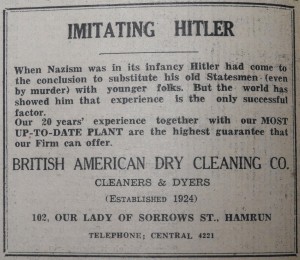 Other adverts such as the one for Dettol portrayed the company’s involvement in the war efforts and reminded that the product should be used with “measured care” in order to keep the supply flowing.
Other adverts such as the one for Dettol portrayed the company’s involvement in the war efforts and reminded that the product should be used with “measured care” in order to keep the supply flowing.Marketers have always adapted to changing business demands when it comes to creating new advertisements. However, there are moments when their creativity is quite shocking – “Imitating Hitler” screams the title in bold capital letters of the British American Dry Cleaning Co.
(This feature was published in the Christmas Supplement issued with the Times of Malta dated 1st December 2019)
Travelogue
Archives
Recent Posts
- A MATTER OF FATE
- MALTA’S PREHISTORIC TREASURES
- THE MAGIC IS IN THE DETAIL
- THE SELLING GAME
- NEVER FORGOTTEN
- Ġrajjiet mhux mitmuma – 35 sena mit-Traġedja tal-Patrol Boat C23
- AN UNEXPECTED VISIT
- THE SISTERS OF THE CRIB
Comments
- Pauline Harkins on Novella – Li kieku stajt!
- admin on IL-KARNIVAL TRAĠIKU TAL-1823
- Albert on IL-KARNIVAL TRAĠIKU TAL-1823
- Martin Ratcliffe on Love in the time of war
- admin on 24 SENA ILU: IT-TRAĠEDJA TAL-PATROL BOAT C23